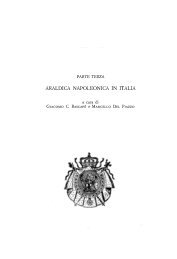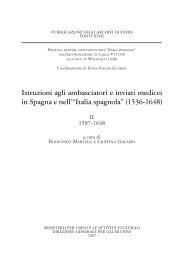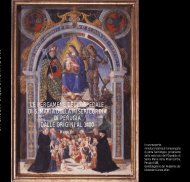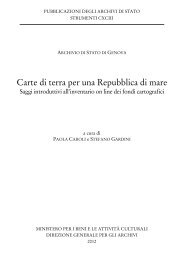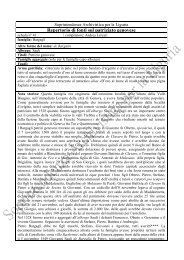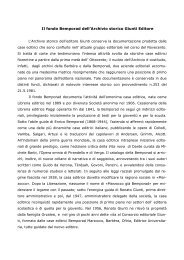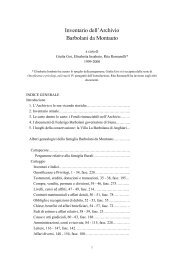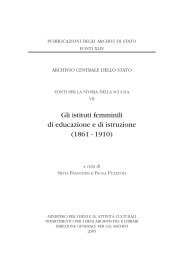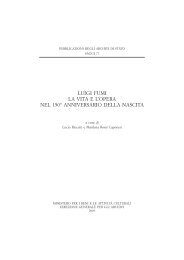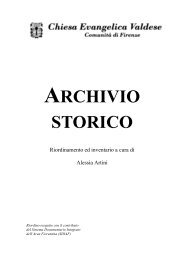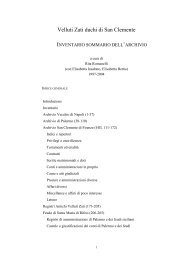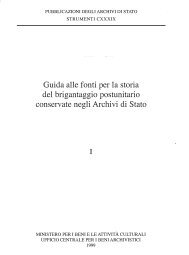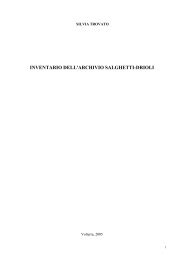ITALIA JUDAICA. Atti del I Convegno internazionale. Bari 18-22 ...
ITALIA JUDAICA. Atti del I Convegno internazionale. Bari 18-22 ...
ITALIA JUDAICA. Atti del I Convegno internazionale. Bari 18-22 ...
Create successful ePaper yourself
Turn your PDF publications into a flip-book with our unique Google optimized e-Paper software.
certain midrashic compilations are, in their final form, of Italian provenance;<br />
(3) Shabbetai Donnolo's report about the death of ten prominent scholars in<br />
925 )1; (4) the achievement of R. Meshullam ben Kalonymos of Lucca, most<br />
of whose work was done in Italy rather than Germany, and the generai role<br />
of Italy as intermediary in transmitting Palestinian teachings to Afhkenaz<br />
(emphasized since the time of S. Y. Rappoport), even though the great for<br />
mative influence of Babylonian teachings is now being more fully assessed u;<br />
(5) the reports of Al;imaiiz concerning his family contributions to Talmudic<br />
scholarship, liturgical poetry, and statesmanship as well as his comments<br />
concerning Abu Aharon of Bagdad who found 'already established' schoals<br />
at Oria; (6) the powerful Italian-Byzantine axis, suggested by the above and<br />
abetted by numerous other indications; (7) the 'Arukh composed by R. Natan<br />
b. Yehi'el of Rome; (8) the two important manuscripts of the Mi'Shnàh<br />
which originated in Italy at the end of the eleventh century 13; (9) the Mifhnàh<br />
Commentary (on Zera'im and !,oharot) of R. Isaac b. Melkizedek of Siponto,<br />
the 'Greek rabbi' apparently used by Maimonides, lavishly praised by some<br />
contemporaries, and sharply criticized by Rabad, as well as references to his<br />
father and son (Shilo); (10) R. Solomon ben ha-Yatom and his commentary<br />
on the Talmudic tractate Mo'ed qatan (or Mashkin); (11) references to hakhme<br />
Romi both those living in Rome and those emigrating elsewhere (e.g., Wotms);<br />
(12) the scholars mentioned by Benjamin of Tu<strong>del</strong>a; (13) R. Tam's rhapsodic<br />
declatation in his Sefer ha-Yashar concetning <strong>Bari</strong> and Otranto '''N:! ':'<br />
't)l"t)'N 'l'l '1::" ;''1,n NlIn ; (14) the Tanya Rabbati 14; (15) R. Isaiah ben Mali<br />
of Trani (Rid), a prodigious author to whom we shall return; (16) R. Zedekiah<br />
ben Abraham Anaw and his important compilation Shibbolai ha-Leqet. While<br />
sketching this histoty, the fol!owing piace names would be mentioned: <strong>Bari</strong>,<br />
Brindisi, Lucca, Milan, Oria, Otranto, Pavia, Rome, Siponto, Taranto, Trani,<br />
Venosa, Verona - and they would ring a bel! al! were seats of learning.<br />
1 1 Se-e A. SHARF, The Universe 01 S. Donnola, New York, 1976. Prof. S. Abramson<br />
has shown how R. Moses of Coucy made use of Donnolo's Ifakhmoni in the Sefer Mizwot<br />
Gadol; see Sinai, LXXX (1976/77), pp. 211-213.<br />
U See especially, A. GROSSMAN, lfakme Ashkenaz, p. 31 and the review by 1. TA<br />
SHEMA, Kiryat Seler, LVI (1981), pp. 344·352.<br />
13 This was already noted by Cassuto. Prof. J. Sussman reviews the matter in bis<br />
artide on the history of MiJhnàb manuscripts which is to appear in the Proceedings of tbe<br />
Seventh World Congress of ]ewish Studies. I was pleased to receive a copy of the gaIleys.<br />
lt is dear from this that MiJhnàb study was prominent in southern Italy, but there<br />
is not much that we are able to say about it on the basis of impersonaI paleographic evidence.<br />
Tbe role of Italian scholars as transmitters is also underscored, but again without<br />
much personal or methodological information.<br />
14 See tbe basic study of Y. Z. PEINTOCH in Sinai, LXXX (1976/77), pp. 14-25. This<br />
book is frequently quoted in later times (e.g. by R. JOSEPH KOLON) and is seen as a repository<br />
of Italian customs (e.g. R. GEDALYAH IBN YAHYAH); see M. SHULVASS, lfayye ha<br />
Yebudim be-'Italyah, New York 1955, p. 256.<br />
388<br />
These Ìtems, in short, together with a revÌew of contacts and infIuences<br />
from and upon other centers as \Vell as references in related genres (such as<br />
Jacob Anatoli's Derashot or Hillel of Ve onù Tagmulei ha-Nefesh), are the<br />
chapter headings for a history of rabb1nlC hterature 1n Italy. !h matenal<br />
is indeed substantive and significant. If \Ve then revert to ha-Me In s sc:I:eme,<br />
\Ve are ali the more puzzIed by his omission of I taly. We would expect hiffi to<br />
have mentioned someone - perhaps R. Natan ben Yehi'e! of Rome - as <br />
fifth «father of Talmudic study », alongside of Rash1, R. Juda Albargelom<br />
and R. Isaac Alfasi. There is no reason te assume that ha-Iv1e In, extremely<br />
erudite and generally comprehensive, was tottIlly unaware of these developments<br />
nor is there reason to accuse ha-Me'iri of parochialism or intentional neglect.15<br />
There \vere literaty and personal connections between Provence a d Italy. hat<br />
then is the meaning of his silence concerning Italy in light of h1S generai histo<br />
rical scheme and the many details concerning the other centers ? It can<br />
only be that in addition to the geographic-territorial lack of unity - : - Italy<br />
has been described by historians as a «geographic expreSSlOn », Iackmg any<br />
politica! unification unti! modern times : - ha-l'vie'iri . dd not perceive an !<br />
conceptual, literary, or methodological umty and contlllmty. Apparently, 1t<br />
was 110t even a geographic.cultural idea comparable to Asbkenaz or Sefarad.<br />
(Liturgical custom - minhag Italiani or minhag Rami - is a sep rate issu ;<br />
it certainly indicates unity an2 continuity in an important sphere, \V1th halakhlc<br />
repercussions, but is not a surrogate for hard-core rabbic li er ture).16 !he<br />
development must have appeared to him as sparse nd epIs . odIC m cO lpanson<br />
with the other major centers which he was chroniclmg succmctly and 111 broad<br />
strokes. Finally, their achievements were not, in his opinion, \vi<strong>del</strong>y influen<br />
tial or famous, an important criterion for him. There was no 'Schoo . l. .<br />
Moreover, it would appear that the Italian rabbis themselves exh1blted no<br />
awareness of continuity and made no explicit or implicit c1aims to bemg part<br />
of 'a local schooI. From the very beginning it was more of a receptive center,<br />
across which successive ripples or waves of influence washed. It transmitted<br />
to Ashkenaz and, in turn, received, for example, from R. Gershom. R, Natan<br />
of Rome, who te be sure trave1led to several ltalian cities and was both stu<br />
dent of and successor to his father as head of the ROlLe yeshivah, also went te<br />
Narbonne to study with R. Moses ha·Darshan, inter alia. His • Aruklp appatently<br />
inteo-rates material from Geonic traditions, R. Hanan'el's commentaries, the<br />
Ashkenazic teachings emanating from Mainz, and Provençal interpretations.<br />
R. Isaac ben Malkizedek cites R. Daniel of Rome together with R. Hai Gaon<br />
and R. Nissim Gaon. Both use multi-lingual vernacular glosses. There is<br />
15 To be sure a cursory inspection reveals that these are very few references to Italian<br />
scholars but he does mention thc (Arukh. The question of his knowledge and use of<br />
I talian abbis deserves a full and careful review.<br />
16 See, e.g., tbe relevant chapters in E. D. GOLDSCHMIDT, Me1;.ere Tefillah u-Fiyyut,<br />
Jerusalem 1980.<br />
389<br />
Hl<br />
'. '.1<br />
,



